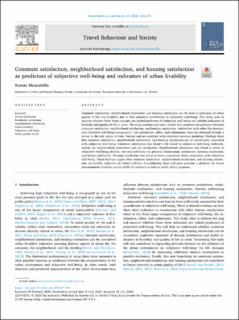| dc.contributor.author | Mouratidis, Konstantinos | |
| dc.date.accessioned | 2021-03-26T12:47:19Z | |
| dc.date.available | 2021-03-26T12:47:19Z | |
| dc.date.created | 2020-08-14T10:02:52Z | |
| dc.date.issued | 2020 | |
| dc.identifier.citation | Travel Behaviour & Society. 2020, 21 265-278. | en_US |
| dc.identifier.issn | 2214-367X | |
| dc.identifier.uri | https://hdl.handle.net/11250/2735754 | |
| dc.description.abstract | Commute satisfaction, neighborhood satisfaction, and housing satisfaction can be used as indicators of urban quality of life and livability due to their potential contribution to subjective well-being. This study aims to uncover whether these three concepts are indeed predictors of subjective well-being and reliable indicators of livability and quality of life in cities. The study presents and tests a model that examines the pathways between commute satisfaction, neighborhood satisfaction, and housing satisfaction, satisfaction with other life domains, and subjective well-being components – life satisfaction, affect, and eudaimonia. Data are obtained through a survey in the city region of Oslo, Norway and are analyzed with structural equation modeling. Findings show that commute satisfaction, neighborhood satisfaction, and housing satisfaction are all significantly associated with subjective well-being. Commute satisfaction was found to be linked to subjective well-being indirectly, mainly via neighborhood satisfaction and job satisfaction. Neighborhood satisfaction was found to relate to subjective well-being directly, but also indirectly via personal relationships satisfaction, housing satisfaction, and leisure satisfaction. Housing satisfaction was found to have a significant direct association with subjective well-being. These findings suggest that commute satisfaction, neighborhood satisfaction, and housing satisfaction are reliable indicators of urban livability. Consolidating these indicators provides a platform for future measurements of urban quality of life for research as well as public policy purposes. | en_US |
| dc.language.iso | eng | en_US |
| dc.relation.uri | https://doi.org/10.1016/j.tbs.2020.07.006 | |
| dc.rights | Navngivelse 4.0 Internasjonal | * |
| dc.rights.uri | http://creativecommons.org/licenses/by/4.0/deed.no | * |
| dc.title | Commute satisfaction, neighborhood satisfaction, and housing satisfaction as predictors of subjective well-being and indicators of urban livability | en_US |
| dc.type | Peer reviewed | en_US |
| dc.type | Journal article | en_US |
| dc.description.version | publishedVersion | en_US |
| dc.source.pagenumber | 265-278 | en_US |
| dc.source.volume | 21 | en_US |
| dc.source.journal | Travel Behaviour & Society | en_US |
| dc.identifier.doi | 10.1016/j.tbs.2020.07.006 | |
| dc.identifier.cristin | 1823287 | |
| cristin.ispublished | true | |
| cristin.fulltext | original | |
| cristin.qualitycode | 1 | |

